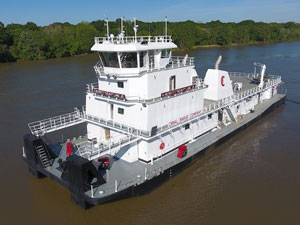The brownwater industry, for a number of reasons, has been slow to embrace EPA Tier 4 propulsion. Canal Barge Co. is a notable exception.
The New Orleans-based operator took delivery this spring of the 6,000-hp H. Merritt ‘Heavy’ Lane Jr., built by Conrad Shipyard. Louisiana-based MiNO Marine designed the 166-by-49-foot vessel now considered the flagship of Canal’s fleet.
The towboat is named for the late Harry Merritt Lane Jr., a former Canal Barge executive and director. His sons, David and Merritt Lane, also work for the company.
Propulsion consists of twin 3,000-hp EMD Tier 4 engines turning 110-inch Sound propellers through Reintjes reduction gears. The package is designed to push 30 or more barges along the Mississippi River system and maintain a 10-knot running speed. The vessel also has Becker high-lift steering rudders.
“We are excited to bring online this new state-of-the-art towing vessel, which is the first 6,000-hp EMD of its kind on the inland waterways,” H. Merritt Lane, III, president and CEO of Canal Barge Co., said in a statement.
The design for H. Merritt ‘Heavy’ Lane Jr. was inspired by the legendary Super Hydrodyne hull developed years ago by St. Louis Ship. Towboats built to this design were known for being efficient and maneuverable, and featured unique curvature in the hull form.
David Bourg, managing partner at MiNO Marine, said the company developed an entirely new design optimized through a detailed analysis. MiNO’s design brings consistent water to the props in all conditions, reducing vibration caused by unsteady water flow.
“We tried to refine the hull to something we thought would be more efficient and get water efficiently to the propellers, especially in shallow water,” Bourg said in an interview this spring.
The superstructure atop the hull is divided into two sections: The forward section with crew living spaces sits atop Trelleborg Marine airbags that reduce engine noise and vibration; the aft section close to the engine spaces is fixed to the hull.
“It is kind of like an inflatable bladder,” Bourg said of the Trelleborg system. “I think we have 48 of them under the forward house with the accommodations spaces and the bridge. The pressures can be tuned up to help dampen or isolate vibration from things like the engines or the props.”
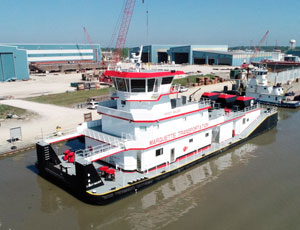 |
|
Randy Mauer is the fifth 6,600-hp triple z-drive towboat in a series built for Marquette Transportation. |
|
C&C Marine |
“The floating house, along with strict attention to detail related to the installation of the joiner system, has resulted in a vessel that is extremely quiet and comfortable for the crew during all operating ranges,” Mike Stone, Canal Barge manager of vessel engineering, said in a statement.
H. Merritt ‘Heavy’ Lane Jr. has tankage for 130,000 gallons of marine diesel fuel. It also can hold 15,000 gallons of diesel exhaust fluid in two tanks for the EMD engines.
Randy Mauer
Marquette Transportation took delivery this spring of a 6,600-hp triple z-drive towboat built by C&C Marine and Repair of Belle Chasse, La. Randy Mauer is the fifth in a series of 160-by-50-foot vessels designed by CT Marine of Portland, Maine.
The towboat shares the same characteristics as its four predecessors, starting with lead boat Cindy L. Erickson, delivered in early 2018. Propulsion comes from three Cummins QSK60-M main engines paired with Steerprop SP25D azimuthing drives. The drives also operate at lower engine loads for better fuel economy.
Vessels in this series have a superstructure set on a bed of springs to reduce noise and vibration within the crew spaces, which also feature a soft-core joiner system. There are nine cabins on board with berthing for 13 people.
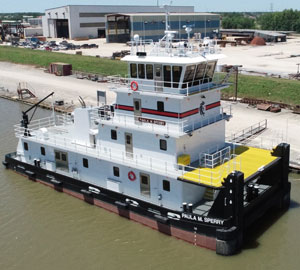 |
|
Centerline Logistics chartered Paula M. Sperry from Maritime Partners. |
|
C&C Marine |
Paula M. Sperry
Centerline Logistics chartered the 84-by-34-foot Paula M. Sperry, built by C&C Marine and Repair of Belle Chasse, La. The vessel is the lead boat in a 15-vessel order from Maritime Partners based on plans developed by Entech Designs.
Propulsion aboard the 2,600-hp Paula M. Sperry comes from twin Cummins QSK38-M1 Tier 3 main engines paired with Reintjes WAF 665 reduction gears. There are two Patterson 40-ton winches on the deck, as well as Nabrico 12-inch roller-button chocks. The vessel has accommodations for six people.
Seattle-based Centerline, formerly Harley Marine Services, has assigned Paula M. Sperry to New Orleans, where the company is launching a bunkering operation starting June 1. It will typically operate with a four-person crew.
Darrell Hiatt
Steiner Construction of Bayou La Batre, Ala., delivered the 2,520-hp Darrell Hiatt to Maritime Partners in spring 2020. The vessel will supply bunkers in Galveston, Texas, while under charter by Centerline Logistics.
Farrell & Norton Naval Architects, with offices in Maine and Massachusetts, designed the 88-by-34-foot vessel. Propulsion comes from twin Mitsubishi Tier 3 engines turning Sound propellers through Twin Disc reduction gears.
Schuyler Cos. supplied the maritime fendering, and the 40-ton deck winches are from Wintech. Two 99-kW John Deere gensets provide ship service power.
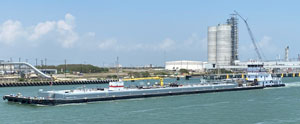 |
|
Raymond Butler pushes the bunker barge Takeuchi Sea in Texas. |
|
Centerline Logistics |
Raymond Butler
Maritime Partners took delivery of another 2,600-hp pushboat, Raymond Butler, from John Bludworth Shipyard in Corpus Christi, Texas. Centerline Logistics has also chartered this vessel to provide bunkering services to vessels calling in Corpus Christi.
The 84-by-32-foot Raymond Butler has a 34-foot height of eye and a 10.5-foot maximum draft. Propulsion comes from twin 1,300-hp Cummins QSK38-M Tier 3 engines turning 82-by-62-inch four-blade Sound propellers through Reintjes WAF 665 reduction gears. Two 99-kW Cummins QSB7-DM gensets provide electrical power.
Raymond Butler has two Patterson 40-ton winches and two Quincy 325 air compressors on deck, along with laminated rubber fenders supplied by M&M Bumper Service. The vessel can carry 38,000 gallons of fuel, 14,000 gallons of water and 600 gallons of lube and machinery oils.
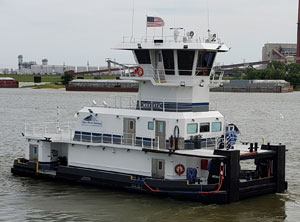 |
|
CT Marine of Portland, Maine, designed Mendota. |
|
C&C Marine |
Mendota
Upper River Services of St. Paul, Minn., took delivery last summer of the triple-screw towboat Mendota built by C&C Marine and Repair.
CT Marine of Portland, Maine, designed Mendota to operate in shallow waterways and narrow stretches of the Upper Mississippi River between Red Wing, Minn., and Minneapolis, and the Minnesota River as far west as Savage, Minn. It is the first newbuild vessel of Upper River Services, which was founded in 1984.
Propulsion on the 76-by-30-foot towboat comes from three Caterpillar C18 ACERT engines, while two John Deere 4045 PowerTech diesel generators provide ship service power. Mendota is equipped with a Novec 1230 “clean agent” fire suppression system.
Annapolis
Vane Brothers took delivery of the 3,000-hp pushboat Annapolis in early 2020. Chesapeake Shipbuilding of Salisbury, Md. — a longtime Vane Brothers partner — designed and built the 94-by-34-foot vessel.
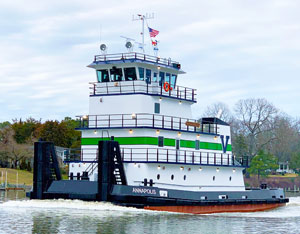 |
|
Annapolis is the second of four new Vane Brothers pushboats. |
|
Vane Brothers |
Annapolis is the second tug in a four-boat series, following last year’s delivery of lead boat Salisbury, built to operate on inland waterways. The four vessels in the series are constructed to Coast Guard Subchapter M standards.
“Annapolis, like Salisbury before her, is an extremely robust inland pusher,” said Vane Port Capt. Jim Demske. “With a solid and sturdy design that delivers unsurpassed performance and safety, Vane Brothers’ crew-friendly Salisbury-class tugs can work efficiently and handle well in both shallow-draft areas and open-water environments.”
Propulsion comes from twin Cat 3512 Tier 3 engines delivering 1,500 hp each. Simrad and Furuno navigation electronics populate the wheelhouse, which is also equipped with dual Rose Point electronic charting systems. Demske described the vessels as quiet and spacious, with independent heating and cooling systems that operate independently throughout the vessels.
Stephanie Pasentine
Florida Marine Transporters took delivery this spring of the 120-foot Stephanie Pasentine, which joins more than a dozen sister vessels built at multiple shipyards around the Gulf. This one, however, is the first built at Metal Shark Alabama, which took over the former Horizon Shipbuilding yard after its bankruptcy in late 2017.
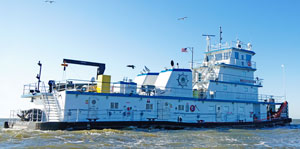 |
|
Stephanie Pasentine is the first new towboat built by Metal Shark Alabama. |
|
Metal Shark |
Gilbert Associates of Boston designed the vessel, which features a developed propeller tunnel that Gilbert believes provides superior performance by ensuring consistent water flow to the propellers.
“We have had quite a lot of success with it, as evidenced by all of the sister vessels,” naval architect John Gilbert said in a recent interview. “The performance is there.”
The propulsion package consists of two 2,011-hp Caterpillar 3512 Tier 3 engines turning 100-by-69-inch stainless-steel propellers through Twin Disc MGX-5600DR reduction gears at a 6.56:1 ratio. Electrical power comes from two John Deere 6090 gensets each producing 175 kW.
Stephanie Pasentine has accommodations for nine people and is certified under Coast Guard Subchapter M. It can hold 75,000 gallons of fuel, 14,750 gallons of fresh water and 1,500 gallons of lube oil.

